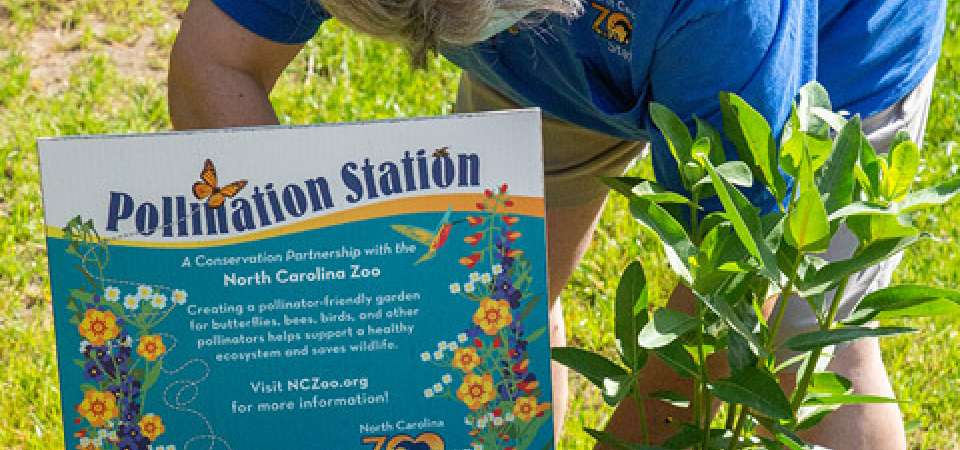


The Zoo anticipates high attendance on sunny weekends. Parking is limited, so arrive early, carpool, and check our site / social pages often for more updates!



Insect populations are declining across the world. One iconic species that has suffered steep declines in recent decades is the monarch butterfly. One of the reasons for these declines is a lack of food and shelter during their annual journey between the northern United States and Mexico. To support migratory monarchs during their annual migration, the North Carolina Zoo has set up several Pollination Stations. The Zoo’s stations were carefully planned to support the monarchs through all their life stages. The Zoo is currently experimenting with different plant mixes to better understand which plants are most liked by the monarchs, as well as other pollinating insects visiting the Zoo grounds.
Because insects are all around us—in the soil, water, and air—it is easy to take their presence for granted. But a series of scientific studies have recently highlighted that the world’s insects are in serious trouble. A 2017 study from Germany found that flying insects declined by three quarters over the past three decades, while a 50% decline in British farmland birds was also attributed to the slow disappearance of insects. Because insects play many important roles in the natural world, their declines could have dire consequences for humans too. Consider for example a world without fruit; most of our fruit crops are insect-pollinated.
Large-scale studies in North America suggest our insect populations are also in trouble. One iconic species that have suffered steep declines in recent decades is the monarch butterfly. Regular monitoring has revealed that the eastern North American monarch population has undergone a ten-fold drop over the past decade. As with other insects, there are several causes driving the monarch’s decline, including climate change, habitat loss, loss of feeding resources, and rampant pesticide use. The monarch is also a migratory species that makes the long journey between their overwintering grounds in Mexico and summer grounds in the northern United States twice a year. This movement puts them at a unique disadvantage compared to other sedentary species, because they depend on healthy environments not only at the end points of their journey, but also along their migratory path where they can rest and refuel.
To help support the monarch and other pollinators, and to demonstrate how simple and attractive these conservation gardens can be, the North Carolina Zoo has established several Pollination Stations. To be effective rest and refueling stops for migrating monarchs, stations need to be carefully set up to provide food for caterpillars, nectar for adults, and sufficient vegetation to provide shelter for all butterfly life stages. Consequently, the plants present at the stations have been chosen to provide a steady food supply throughout the growing season, especially in the fall during the monarch migration. One particularly important plant that needs to be present at the monarch stations is milkweed, the only food source for monarch caterpillars.
The North Carolina Zoo’s first Pollination Station was established in the spring of 2016 at the Solar Pointe picnic area. To great excitement, this garden was already hosting monarch butterflies on their way to Mexico by the fall of 2016. Encouraged by the success, three more stations were added in the spring of 2017: one across from the entrance to the Polar Bear habitat; one across from the Honeybee habitat and one in front of Stedman Education Building. The establishment of additional stations not only help the Zoo better support monarchs, but also help us understand how to provide better care for other pollinators, for example by monitoring which plants are most liked by pollinators visiting the Zoo grounds.
Several monarch waystations can be found around the Zoo in areas like Kidzone and the Kaleidoscope Butterfly Garden, providing safe haven for migrating monarchs and habitat for other local pollinators and also demonstrating how simple it is to create pollinator habitat. Recently, the Zoo has also been working closely with the community to share expertise in the creation of Pollination Stations. Working with community partners, we have installed Pollination Stations made with recycled containers and decorated by children at three Randolph County preschool sites and one at the Child Development Center at Davidson County Community College.
The Zoo’s preschool pollinator program has also been incorporated into teacher trainings. The overall goal is to create pockets of plant diversity that support local pollinator species, help local schools meet curriculum guidelines, and reinforce community partnerships. Pollination Stations are also part of the Zoo’s contribution to the nationwide efforts of the Monarch Butterfly SAFE program.
Visitors who would like to grow their own Pollination Station to attract and help support these beautiful butterflies can find more information on the MonarchWatch Waystations page. Also keep an eye out for special events at the Zoo to promote monarch conservation. These events, held annually during spring and summer, provide an opportunity to get your questions answered by experienced Pollination Station growers. During some events, the public may also obtain free seeds (while they last) with station setup information, buy native plants that attract pollinators at the Annual Zoo Horticulture plant sale, and learn how to monitor monarchs in your own garden.
Partners: Several North Carolina Zoo Departments, many Zoo Volunteers